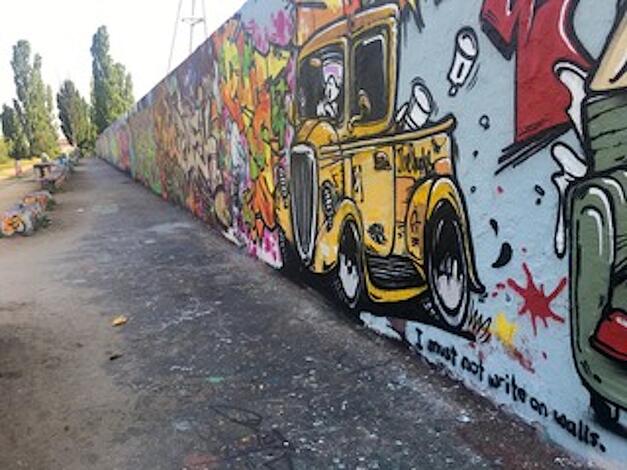
This article was originally published on March 3, 2021.
When the Berlin Wall fell, History Assistant Professor Kristin Poling remembers watching news broadcasts and hearing her phone ringing throughout her parents’ home with German relatives on the other end.
In the childhood memory, Poling said the excitement was felt from her family in Berlin all the way to her home in the U.S. The 1989 world event made an impression on her formative years and she’s devoted her academic research to exploring the ideas behind physical walls, the historic reasons behind them, why governments continue to build, and the communities — meaning the regular people — they impact.
“I wanted to study walls and their removal not as a process or as a side effect, but as an experience of individual communities and people,” she said.
Poling’s publications include her book “Germany's Urban Frontiers: Nature and History on the Edge of the Nineteenth-Century City.” She’s also given presentations on the topic of border walls, and has shared research experiences with her students at UM-Dearborn in courses that cover the history of revolution, the modern city and Germany since the nineteenth century.
Reflecting on global connections, changes in U.S. administrations, European history, and the presence of walls, Poling recently spoke with UM-Dearborn’s Reporter about her research and conclusions she’s drawn based on her 15 years of border wall studies.


Question: Do you view walls as helpful or hurtful?
Kristin Poling: It’s important to understand that walls don’t do things. When we talk about walls — let’s say the U.S.-Mexico Border wall or walls throughout history — we often talk as if putting a physical boundary there does something on its own. The wall is passive; those in power are using the wall to actively represent their points of view or policies. That can be especially triggering because putting a wall where there wasn’t one before feels like regression in our modern era of flattening boundaries. A Washington Post column that I found interesting, “Trump’s Wall isn’t Evil, it’s Medieval,” focuses on this and notes that building a wall for national security is an ancient world tactic, and suggests that we need to go “more Byzantine” for it to truly be effective.
What was so evident to me in my research is that walls on their own aren’t very powerful. It’s what they symbolize. People take down walls or build them to say something about their communities or the communities around them.
Q: Do leadership changes signify an opportunity for progress?
Poling: There is always potential, but people have to be committed to putting in the work for open communities. There is new leadership in the U.S., but, when it comes to borders and walls, I’m not sure which direction we are headed in as a country yet.
Progress is never guaranteed. It’s not something that happens automatically with time. People think that somehow things progress on their own — that’s a myth. You have to work hard for change.
Q: Can a grassroots movement take down a wall?
Poling: Anything is possible, but — looking at history — boundaries don’t usually just disappear. We often picture the tearing down of walls as once-and-for-all moments tied to a radical shift. The truth is things typically move more slowly than that.
Looking at Leipzig, Germany, the wall around their city took more than a century to tear down. People lived with it in stages of removal starting in the mid-1700s. First, there were decades of semi-intentional neglect and gardens were planted along the edges. Then pieces of the wall began to come down to make it a more welcoming marketplace. City gates were opened for unrestricted traffic. Moats were later filled in. Lastly, a policed border for the exaction of excise taxes ended in the 1860s. It wasn’t a sudden breaking down of a boundary; it was living with partial, broken and temporary boundaries. In retrospect, the process seemed inevitable — and much quicker than it had actually been.
It’s important to note that change has to start somewhere. Slow change in a direction that’s better for society is better than no change.
Q: What can learn from history when it comes to wall building?
Poling: There have been a few big books on the history of walls in the past few years that reflect on the current conversations in the United States. What drives me crazy is when the lesson people take from history is that walls are a naturalized expression of an “us vs. them” attitude. I don’t think that’s entirely true. What I get from looking at the history of boundaries is they are in fact about the face we want to present to the world. Who we keep in and who we keep out is more about making a statement about how we want others to see our community identity.
Q: Through your wall research, what have you learned about human nature?
Poling: One of the things I realized when studying the Berlin Wall was that people naturalize their environment no matter what it looks like. In both East and West Germany, you could find arguments on why there was a border in the middle of the city — reasons included differences in how the city grew, and the economic and class differences between East and West Berlin. People try to make sense of their environments.
My research also has made me aware of how much we as human beings see our stories in spaces. We live in spaces that we have pre-inscribed with all these stories about who we are — that’s within built landscapes like walls or natural landscapes. Once we inscribe a story about our identity into a space, then it becomes hard to change or challenge. Realizing how stories about identity and the spaces we live in develop together has made me realize that we can also challenge these assumptions about ourselves and the ways we relate to the world. We hold power. Our identity doesn’t need to be tied to a space within a border.
Interview by Sarah Tuxbury. If you're a member of the media and would like to contact Assistant Professor Kristin Poling for an interview on this topic, drop us a line at UMDearborn-News@umich.edu.



